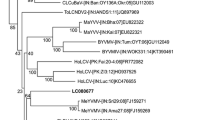Abstract
The complete sequences of a begomovirus and an associated betasatellite isolated from Croton bonplandianus originating from Pakistan were determined. The sequence of the begomovirus showed the highest level of nucleotide sequence identity (88.9%) to an isolate of papaya leaf curl virus and thus represents a new species, for which we propose the name Croton yellow vein virus (CYVV). The sequence of the betasatellite showed the highest levels of sequence identity (82 to 98.4%) to six sequences in the databases that have yet to be reported, followed by isolates of tomato leaf curl Joydebpur betasatellite (48.7 to 52.5%). This indicates that the betasatellite identified here (and the six sequences in the databases) is an isolate of a newly identified species for which the name Croton yellow vein mosaic betasatellite (CroYVMB) is proposed. For the begomovirus, an analysis of the sequence indicates that it has a recombinant origin.


Similar content being viewed by others
References
Amin I, Mansoor S, Iram S, Khan MA, Hussain M, Zafar Y, Bull SE, Briddon RW, Markham PG (2002) Association of a monopartite begomovirus producing subgenomic DNA and a distinct DNA β on Croton bonplandianus showing yellow vein symptoms in Pakistan. Plant Dis 86:444
Argüello-Astorga G, Herrera-Estrella L, Rivera-Bustamante R (1994) Experimental and theoretical definition of geminivirus origin of replication. Plant Mol Biol 26:553–556
Argüello-Astorga GR, Guevara-González LR, Herrera-Estrella LR, Rivera-Bustamante RF (1994) Geminivirus replication origins have a group-specific organization of iterative elements: a model for replication. Virology 203:90–100
Argüello-Astorga GR, Ruiz-Medrano R (2001) An iteron-related domain is associated to motif 1 in the replication proteins of geminiviruses: identification of potential interacting amino acid-base pairs by a comparative approach. Arch Virol 146:1465–1485
Briddon RW, Markham PG (1994) Universal primers for the PCR amplification of dicot-infecting geminiviruses. Mol Biotechnol 1:202–205
Briddon RW, Bull SE, Mansoor S, Amin I, Markham PG (2002) Universal primers for the PCR-mediated amplification of DNA β; a molecule associated with some monopartite begomoviruses. Mol Biotechnol 20:315–318
Briddon RW, Stanley J (2006) Sub-viral agents associated with plant single-stranded DNA viruses. Virology 344:198–210
Briddon RW, Brown JK, Moriones E, Stanley J, Zerbini M, Zhou X, Fauquet CM (2008) Recommendations for the classification and nomenclature of the DNA-β satellites of begomoviruses. Arch Virol 153:763–781
Chowda Reddy RV, Colvin J, Muniyappa V, Seal S (2005) Diversity and distribution of begomoviruses infecting tomato in India. Arch Virol 150:845–867
Doyle JJ, Doyle JL (1990) Isolation of plant DNA from fresh tissue. Focus 12:13–15
Fauquet CM, Bisaro DM, Briddon RW, Brown JK, Harrison BD, Rybicki EP, Stenger DC, Stanley J (2003) Revision of taxonomic criteria for species demarcation in the family Geminiviridae, and an updated list of begomovirus species. Arch Virol 148:405–421
Fauquet CM, Briddon RW, Brown JK, Moriones E, Stanley J, Zerbini M, Zhou X (2008) Geminivirus strain demarcation and nomenclature. Arch Virol 153:783–821
Ilyas M, Qazi J, Mansoor S, Briddon RW (2009) Molecular characterisation and infectivity of a “Legumovirus” (genus Begomovirus: family Geminiviridae) infecting the leguminous weed Rhynchosia minima in Pakistan. Virus Res 145:279–284
Larkin MA, Blackshield G, Brown NP, Chenna R, McGettigan PA, McWilliam H, Valentin F, Wallace IM, Wilm A, Lopez R, Thompson JD, Gibson TJ, Higgins DG (2007) Clustal W and Clustal X version 2.0. Bioinformatics 23:2947–2948
Mansoor S, Zafar Y, Briddon RW (2006) Geminivirus disease complexes: the threat is spreading. Trends Plant Sci 11:209–212
Martin D, Rybicki E (2000) RDP: detection of recombination amongst aligned sequences. Bioinformatics 16:562–563
Mubin M, Briddon RW, Mansoor S (2009) Diverse and recombinant DNA betasatellites are associated with a begomovirus disease complex of Digera arvensis, a weed host. Virus Res 142:208–212
Mubin M, Shahid MS, Tahir MN, Briddon RW, Mansoor S (2010) Characterization of begomovirus components from a weed suggests that begomoviruses may associate with multiple distinct DNA satellites. Virus Genes 40:452–457
Nawaz-ul-Rehman MS, Mansoor S, Briddon RW, Fauquet CM (2009) Maintenance of an Old World betasatellite by a New World helper begomovirus and possible rapid adaptation of the betasatellite. J Virol 83:9347–9355
Page RDM (1996) TREEVIEW: An application to display phylogenetic trees on personal computers. Comput Appl Biosci 12:357–358
Saunders K, Briddon RW, Stanley J (2008) Replication promiscuity of DNA-β satellites associated with monopartite begomoviruses; deletion mutagenesis of the Ageratum yellow vein virus DNA-β satellite localises sequences involved in replication. J Gen Virol 89:3165–3172
Seal SE, van den Bosch F, Jeger MJ (2006) Factors influencing begomovirus evolution and their increasing global significance: implications for sustainable control. Crit Rev Plant Sci 25:23–46
Stanley J, Bisaro DM, Briddon RW, Brown JK, Fauquet CM, Harrison BD, Rybicki EP, Stenger DC (2005) Geminiviridae. In: Fauquet CM, Mayo MA, Maniloff J, Desselberger U, Ball LA (eds) Virus taxonomy, VIIIth report of the ICTV. Elsevier/Academic Press, London, pp 301–326
Acknowledgements
K.H. was supported by a Ph.D. fellowship from the Higher Education Commission (HEC), Government of Pakistan. R.W.B. is supported by the HEC under the “Foreign Faculty Hiring Program”. This research was supported by a research grant under a “Pakistan-USA Collaborative Research” project between NIBGE and Danforth Plant Science Center, USA.
Author information
Authors and Affiliations
Corresponding author
Rights and permissions
About this article
Cite this article
Hussain, K., Hussain, M., Mansoor, S. et al. Complete nucleotide sequence of a begomovirus and associated betasatellite infecting croton (Croton bonplandianus) in Pakistan. Arch Virol 156, 1101–1105 (2011). https://doi.org/10.1007/s00705-011-0993-0
Received:
Accepted:
Published:
Issue Date:
DOI: https://doi.org/10.1007/s00705-011-0993-0




